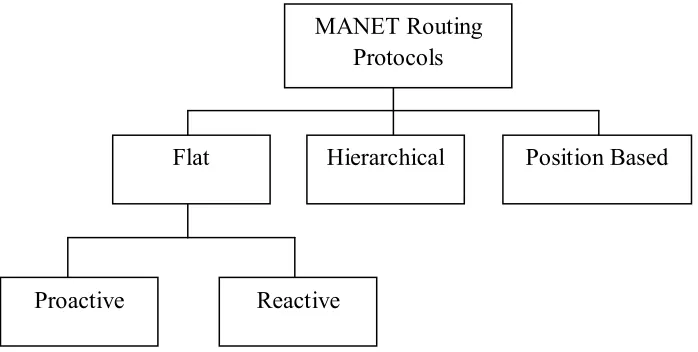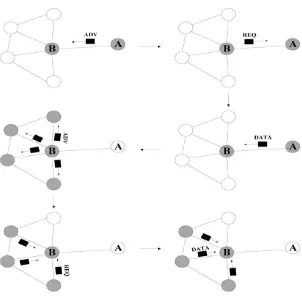ENHANCED AODV FOR EFFICIENT ROUTING PROTOCOL IN WSN
MIOW KY LUEN
ENHANCED AODV FOR EFFICIENT ROUTING PROTOCOL IN WSN
MIOW KY LUEN
This Report is Submitted in Partial Fulfillment of Requirements for the Bachelor Degree in Electronic Engineering (Telecommunication Electronics) with Honours
Faculty of Electronic and Computer Engineering Universiti Teknikal Malaysia Melaka
v
ACKNOWLEDGEMENT
First of all, my deepest appreciation goes to my supervisors, Mr. Mohd Khanapiah bin Nor whose contribute to stimulating ideas, give suggestions and encouragement, also patiently guiding me along with the development of this project.
Besides, I would like to show my gratitude to Dr. Kok Swee Leong for his inestimable and invaluable guidance. He is a very good instructor where he takes his time from his busy schedule to give an introduction about this training program and provided the sources of the modules or courses.
I would also like to extend my gratitude to the most precious persons in my life, my parents and family members for their moral support, financial support and also to my friends for never ending remind me to always be honest, hardworking and trustworthy during the completion of this project.
vi
ABSTRACT
vii
ABSTRAK
viii
TABLE OF CONTENTS
CHAPTER CONTENTS PAGES
TITLE i
DECLARATION iii
APPROVAL iv
ACKNOWLEDGMENT v
ABSTRACT vi
ABSTRAK vii
TABLE OF CONTENTS viii
LIST OF TABLES xii
LIST OF FIGURES xiii
I. INTRODUCTION
1.1 Research background 1 1.2 Motivation and significance of research 2 1.3 Problem Statement 3
ix
1.5 Scope 4
II. LITERATURE REVIEW
2.1 Basic Sensor Network Architectural Elements 5 2.2 Review of Related Works 7 2.3 Proactive Routing Protocols 7
2.3.1 Destination Sequence Distance Vector
Routing (DSDV) 7
2.3.2 Sensor Protocols for Information
via Negotiation (SPIN) 8
2.3.3 Rumour Routing 10
2.3.4 Direct Diffusion 11
2.4 Reactive Routing Protocols 12
2.4.1 Ad-hoc On-Demand Distance
Vector Routing (AODV) 13
2.4.2 Energy Efficient AODV Routing
Protocol (EE-AODV) 14
2.4.3 Energy Balanced AODV 15
2.4.4 Dynamic Source Routing (DSR) 16
2.4.5 Ad-hoc On-Demand Distance Vector Expected Transmission Count
(AODVETX) 17
2.5 Hierarchical Routing Protocols 17
2.5.1 Energy Aware Routing Protocol (EAP) 18
x
2.5.3 Low Energy Adaptive Clustering
Hierarchy (LEACH) 20
2.5.4 Power-Efficient Gathering in Sensor Information Systems
(PEGASIS) 21
2.6 Position Based Routing Protocols 22
2.6.1 Energy Aware Geographic Routing
Protocol (EARGP) 22
2.7 Wireless Sensor Networks Topology Models 23
2.8 Summary and Discussion of the Review 25
III. METHODOLOGY
3.1 Experimental Setup 27
3.1.1 Architecture 28
3.1.2 Component Model 29
3.2 Flow Chart 30
3.3 AODV Implementation 32
3.4 Network Improvement 35
3.5 Network Design 37
xi
IV. RESULT & DISCUSSION
4.1 Introduction 40
4.2 Result 41
V. CONCLUSION
5.1 Conclusion 51
5.2 Recommendation 52
REFERENCES 53
APPENDICES
xii
LIST OF TABLES
NO TITLE PAGES
2.1 Comparison of routing protocols in
wireless sensor networks. 25
4.1 Comparison between EAODV, AODVETX and AODV. 41
4.2 Result parameters in simulation for 10 nodes. 45
4.3 Result parameters in simulation for 20 nodes. 46
xiii
LIST OF FIGURES
NO TITLE PAGES
2.1 Typical sensor network arrangements. 6
2.2 Classification of MANET routing protocols. 6
2.3 Sensor Protocols for Information via Negotiation
(SPIN) routing. 9
2.4 Rumour Routing. 10
2.5 Direct Diffusion protocol. 12
2.6 AODV Protocol Messaging. 14
2.7 Hybrid AODV Algorithms. 19
2.8 Low Energy Adaptive Clustering Hierarchy
(LEACH) protocol. 20
2.9 Chain-based topology used in PEGASIS. 21
2.10 Three kinds of topology models. 24
xiv
3.2 Core interfaces in TinyOS. 29
3.3 Component and interface of a program. 29
3.4 Project flow chart. 31
3.5 AODV route discovery initialization. 32
3.6 Flooding of RREQ in the network. 33
4.1 The average throughput for EAODV, AODVETX
and AODV routing protocol. 42
4.2 The packet delivery ratio for EAODV, AODVETX
and AODV routing protocol. 43
4.3 End-to-End delay for EAODV, AODVETX
and AODV routing protocol. 44
4.4 Comparison of packet delivery ratio for
10 nodes, 20 nodes and 30 nodes. 47
4.5 Comparison of throughput for 10 nodes,
20 nodes and 30 nodes. 48
4.6 Comparison of end-to-end delay for 10 nodes,
1
CHAPTER 1
INTRODUCTION
1.1 Research background
2
major deployment in the next few years [4] for the application of collecting data, controlling, monitoring and inspection. The four basic components in a sensor networks are sensors, network, central point of information clustering and a set of computing resources. In the early stage of WSN, it was being used as radar networks for air traffic control, the national electrical power grid and also use as weather detection. However, these kinds of services required special computers to control the system which lead to high expenses. So, WSNs are being considered to be used in a much less expensive application which is in security, commerce and health monitoring. Besides that, there are many other applications that use WSN such as environmental monitoring, traffic control, industrial sensing and infrastructure security. It is impossible to deliver important information from the environment in real time with wired sensor networks. However, this could be made possible with wireless sensor networks which are used for collection of data and processing the data in real time from environment [5]. The surroundings conditions in the environment are measured and processed by the sensors in order to assess the surrounding situation accurately. The deployment of WSNs can be in manual or random manner, then the sensor nodes will self organize themselves and start communicating each other by sending the sensed data. The two main applications of WSNs can be categorized as monitoring and tracking for various application areas.
1.2 Motivation and significance of research
3
1.3 Problem Statement
There are a few problems in WSN such as packet losses due to transmission errors and mobility, stimulated change of route and battery constraints. One of the most critical issues is energy conservation since nodes will be powered by batteries with limited capacity. Nodes in WSN are always portable devices powered by battery. It will be limited or impossible to replace the power of battery altogether. The main function of a sensor node is to detect event, processing data and transmit the processed data. Energy consuming also should be considered in routing in WSN as sensor nodes power consumption are used in sensing, communication and data processing. Data processing in WSNs involve overwhelming tasks to be performed at the microprocessor in sensor nodes and can cause a significant energy consumption even when compared to the energy consumption during transmission or reception. The power level basically affects many features of the operation in the network including the throughput of the network. So, routing protocol takes an important role in wireless sensor networks in order that the data transmission from source to destination takes time in a short interval. Therefore the energy efficient protocol is a must to increase the lifetime of node as well as the lifetime of network.
1.4 Objectives
The basic objectives of this project are as follows: 1. To study the routing protocol for WSN.
2. To design a routing protocol for WSN.
4
1.5 Scope
5
CHAPTER 2
LITERATURE REVIEW
2.1 Basic Sensor Network Architectural Elements
6
Sensor nodes are placed in an area which is sensor field and each of the sensors typically has the capability to collect and analyze data and route the data to the destination point. Figure 2.1 shows a basic WSN arrangement. Even though there are many environments need to be considered, but all the wireless networks are assume to have the same functionality. There are several parameters need to be concerned for WSNs, such as sensor type, sensor power consumption, sensor arrangement, operating environment, connectivity, sensing capabilities and signal processing.
Figure 2.1: Typical sensor network arrangements.
Figure 2.2: Classification of MANET routing protocols. MANET Routing
Protocols
Position Based Hierarchical
Flat
7
2.2 Review of Related Works
There are many researchers study the routing protocol of WSNs from different aspects such as node deployment, energy consumption, data reporting model, node heterogeneity, fault tolerance, scalability, network dynamics, transmission media, connectivity, coverage, data aggregation and Quality of Service (QoS). For energy efficiency routing protocol of WSN, numerous designs of routing protocol have been suggested to achieve better performance. Therefore, the study of research has been done by other researchers is important to get a rough idea of designing a routing protocol for WSN.
2.3 Proactive Routing Protocols
A proactive routing protocol is also named as table driven routing protocol. The nodes in this protocol constantly evaluate routes with all accessible nodes and try to maintain reliable and up-to-date routing information. So, a source node can immediately determine a routing path if it needs. When the network topology changes, there must be respective updates need to be changed by propagating the information throughout the network. The proactive routing protocols are Wireless Routing Protocol (WRP)[6], Destination Sequence Distance Vector (DSDV)[6] and Fisheye State Routing (FSR)[6].
2.3.1 Destination Sequence Distance Vector Routing (DSDV)
8
Several improvements are made including freedom from loops in routing tables. The mobile nodes in the network create a routing table for every possible destination in the network and the number of hops to each destination node. The routing table consists of all available destinations, the metric and the next hop to each destination. A sequence number is marked for each entry and the number is assigned by the destination node. The routing table was update from time to time throughout the network as to maintain the table consistency with the changing topology of the network. The routes selected are always with the later sequence number, when the sequence numbers are similar, the route with the smallest metric are selected. For a huge amount of network traffic, the route updates can employ two types of packets which are full dump and incremental routing. Full dump will cover many packets by sending the full routing table to its neighbor’s nodes, whereas in incremental routing update those entries in the routing table that with metric change since last update and it must fit in a packet. When the network is rather stable, incremental updates were sent in order to avoid extra traffic and full dump is inactive. In a rapid changing network, incremental packets will grow big and full dumps will be more active.
2.3.2 Sensor Protocols for Information via Negotiation (SPIN)
9
which is implosion, overlap and resource blindness by negotiation. SPIN’s meta-data approach was used to differentiate between various data and identify the redundant data inside a network. It only ensures relevant information is being transmitted. The two main protocols for SPIN are SPIN-1 and SPIN-2, which mainly incorporate in negotiation before data transmission. SPIN-1 protocol is a 3 stage protocol as its sensor nodes use 3 types of message which is ADV, REQ and DATA for communication. SPIN-2 is an extension to SPIN-1 with an additional of threshold based resource awareness mechanism for negotiation. SPIN’s advantages are having high performance at low cost in term of energy, computation, communication and complexity.

